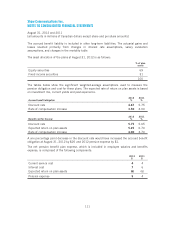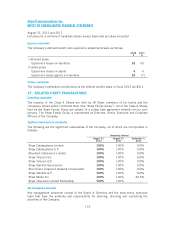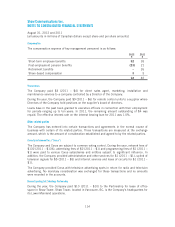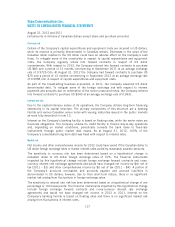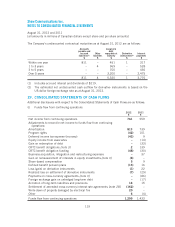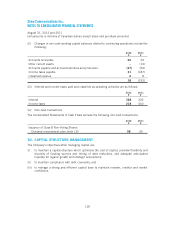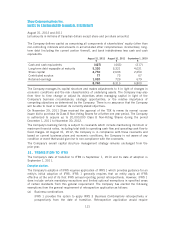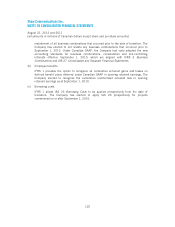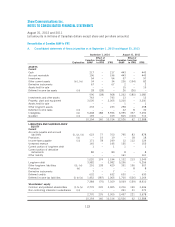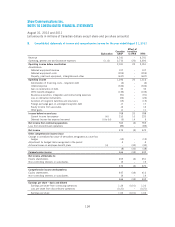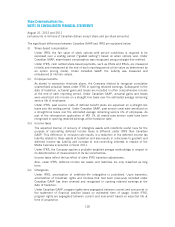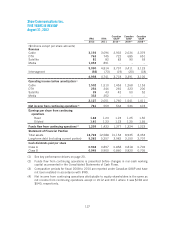Shaw 2012 Annual Report Download - page 125
Download and view the complete annual report
Please find page 125 of the 2012 Shaw annual report below. You can navigate through the pages in the report by either clicking on the pages listed below, or by using the keyword search tool below to find specific information within the annual report.
Shaw Communications Inc.
NOTES TO CONSOLIDATED FINANCIAL STATEMENTS
August 31, 2012 and 2011
[all amounts in millions of Canadian dollars except share and per share amounts]
The Company defines capital as comprising all components of shareholders’ equity (other than
non-controlling interests and amounts in accumulated other comprehensive income/loss), long-
term debt (including the current portion thereof), and bank indebtedness less cash and cash
equivalents.
August 31, 2012
$
August 31, 2011
$
September 1, 2010
$
Cash and cash equivalents (427) (443) (217)
Long-term debt repayable at maturity 5,320 5,321 4,021
Share capital 2,750 2,633 2,250
Contributed surplus 77 73 67
Retained earnings 1,020 729 679
8,740 8,313 6,800
The Company manages its capital structure and makes adjustments to it in light of changes in
economic conditions and the risk characteristics of underlying assets. The Company may also
from time to time change or adjust its objectives when managing capital in light of the
Company’s business circumstances, strategic opportunities, or the relative importance of
competing objectives as determined by the Company. There is no assurance that the Company
will be able to meet or maintain its currently stated objectives.
On November 29, 2011 Shaw received the approval of the TSX to renew its normal course
issuer bid to purchase its Class B Non-Voting Shares for a further one year period. The Company
is authorized to acquire up to 20,000,000 Class B Non-Voting Shares during the period
December 1, 2011 to November 30, 2012.
The Company’s banking facility is subject to covenants which include maintaining minimum or
maximum financial ratios, including total debt to operating cash flow and operating cash flow to
fixed charges. At August 31, 2012, the Company is in compliance with these covenants and
based on current business plans and economic conditions, the Company is not aware of any
condition or event that would give rise to non-compliance with the covenants.
The Company’s overall capital structure management strategy remains unchanged from the
prior year.
31. TRANSITION TO IFRS
The Company’s date of transition to IFRS is September 1, 2010 and its date of adoption is
September 1, 2011.
Exemption elections
The Company’s adoption of IFRS requires application of IFRS 1 which provides guidance for an
entity’s initial adoption of IFRS. IFRS 1 generally requires that an entity apply all IFRS
effective at the end of its first IFRS annual reporting period retrospectively. However, IFRS 1
does include certain mandatory exceptions and limited optional exemptions in specified areas
of certain standards from this general requirement. The Company has elected the following
exemptions from the general requirement of retrospective application as follows:
(a) Business combinations
IFRS 1 provides the option to apply IFRS 3 Business Combinations retrospectively or
prospectively from the date of transition. Retrospective application would require
121


